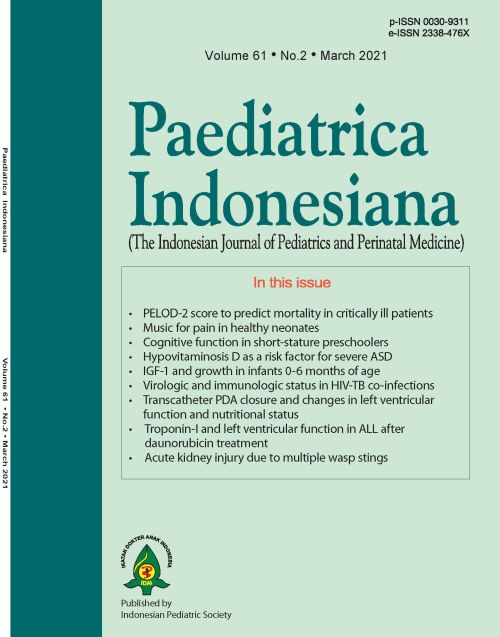Insulin-like growth factor-1 and growth in infants 0-6 months of age
DOI:
https://doi.org/10.14238/pi61.2.2021.89-93Keywords:
umbilical cord IGF-1, IGF-1 at 6 months of age, growthAbstract
Background During infancy, growth is affected by many factors, including hormones. Insulin-like growth factor-1 (IGF-1) is a hormone with an important role in regulating somatic growth and organ development.
Objective To analyze for possible correlations between IGF-1 levels and infant growth from 0-6 months of age.
Methods A prospective study was conducted on 38 infants from birth to 6 months of age. Inclusion criteria were full-term newborns with normal birth weight and singleton birth. Serum IGF-1 was measured twice, from umbilical cord blood at birth and at 6 months of age. Anthropometric measurements were made every three months. Paired T-test was used to analyze mean IGF-1 among time points, and Pearson’s correlation test was used to analyze IGF-1 levels and growth.
Results Mean IGF-1 level decreased from birth to 6 months of age (89.6 ng/mL vs. 48.3 ng/mL, respectively; P<0.001). Delta IGF-1 had positive significant correlations with delta weight at 3 months (r=0.347; P=0.033) and 6 months (r=0.386; P=0.017), as well as delta head circumference at 3 months (r= 0.356; P=0.028) and 6 months (r=0.357; P=0.028). However, there were significant negative correlations between umbilical cord IGF-1 with delta body weight (r= −0.459; P=0.004) and delta length at 6 months (r= −0.414; P=0.010).
Conclusions. There iss a decrease in IGF-1 levels at the first 6 months of life. Umbilical cord IGF-1 level has negative correlations with the weight and length increment at the age of 6 months.
References
2. Savino F, Fissore MF, Grassino EC, Nanni GE, Oggero R, Silvestro L. Ghrelin, leptin and IGF-I levels in breast-fed and formula-fed infants in the first years of life. Acta Paediatr. 2005;94:531-7. DOI: 10.1111/j.1651-2227.2005.tb01934.x
3. Chellakooty M, Juul A, Boisen KA, Damgaard IN, Kai CM, Schmidt IM, et al. A prospective study of serum 
insulin-like growth factor I (IGF-I) and IGF-binding protein-3 in 942 healthy infants: associations with birth weight, gender, growth velocity, and breastfeeding. J Clin Endocrinol Metab. 2006; 91:820-6. DOI: 10.1210/jc.2005-0950
4. Yuksel B, Ozbek MN, Mungan NO, Darendeliler f, Budan B, Bidaci A, et al. Serum IGF-1 and IGFBP-3 levels in healthy children between 0 and 6 years of age. J Clin Res Pediatr Endocrinol. 2011;3:84-8. DOI: 10.4274/jcrpe.v3i2.17
5. WHO Department of Nutrition for Health and Development. WHO Child Growth Standard. Geneva : WHO Press; 2006.
6. Javaid MK, Godfrey KM, Taylor P, Shore SR, Breier B, Arden NK, et al. Umbilical venous IGF-1 concentration, neonatal bone mass, and body composition. J Bone Miner Res. 2004;19:56-63. DOI: 10.1359/JBMR.0301211
7. Kouanda S, Tonglet R, De Coninck V, Doulougou B, Sondo B, Ketelslegers JM, et al. Reference values of IGF-1 in children from birth to 5 years of age, in Burkina Faso, using blood samples on filter paper. Growth Horm IGF Res. 2008:18:345-52. DOI: 10.1016/j.ghir.2008.01.008
8. Mennella JA, Ventura AK, Beauchamp GK. Differential growth patterns among healthy infants fed protein hydrolysate or cow-milk formulas. Pediatrics. 2011;127:110-8. DOI: 10.1542/peds.2010-1675
9. Madsen AL, Larnkjaer A, Molgaard C, Michaelsen KF. IGF-1 and IGFBP-3 in healthy 9 month old infants from the SKOT cohort: breastfeeding, diet, and later obesity. Growth Horm IGF Res. 2011;21:199-204. DOI: 10.1016/j.ghir.2011.05.003
10. Rzehak P, Grote V, Lattka E, Weber M, Gruszfeld D, Socha P, et al. Associations of IGF-1 gene variants and milk protein intake with IGF-I concentrations in infants at age 6 months. Results from a randomized clinical trial. Growth Horm IGF Res.2013;23:149-58. DOI : 10.1016/j.ghir.2013.05.002
11. Puche JE, Cortazar IC. Human conditions of insulin-like growth factor-I (IGF-I) deficiency. J Transl Med. 2012;10:1-29. DOI: 10.1186/1479-5876-10-224
12. Wang X, Xing KH, Qi J, Guan Y, Zhang J. Analysis of the relationship of insulin-like growth factor-1 to the growth velocity and feeding of healthy infants. Growth Horm IGF Res. 2013;23:215-9. DOI: 10.1016/j.ghir.2013.08.001
13. Livingstone C. Insulin-like growth factor-I (IGF-I) and clinical nutrition. Clin Sci. 2013;125:265-80. DOI: 10.1042/CS20120663
14. Gunnell D, Miller LL, Rogers I, Holly JM, ALSPAC Study Team. Association of insulin-like growth factor I and insulin-like growth factor-binding protein-3 with intelegence quotient among 8- to 9-year-old children in the Avon Longitudinal Study of Parents and Children. Pediatrics. 2005;116:681-6. DOI: 10.1542/peds.2004-2390
15. Wiley AS, Joshi SM, Lubree HG, Bhat DS, Memane NS, Raut DA, et al. IGF-I and IGFBP-3 concentrations at 2 years: associations with anthropometry and milk consumption in an Indian cohort. Eur J Clin Nutr. 2018;72:564-71. DOI: 10.1038/s41430-018-0108-z
16. Jansson N, Nilsfelt A, Gellerstedt M, Wennergren M, Rossander-Hulthén L, Powell TL, et al. Maternal hormones linking maternal body mass index and dietary intake to birth weight. Am J Clin Nutr. 2008;87:1743–9. DOI: 10.1093/ajcn/87.6.1743
17. de Jong M, Cranendonk A, Twisk JW, van Weissenbruch MM. IGF-I and relation to growth in infancy and early childhood in very-low-birth-weight infants and term born infants. PLoS One. 2017;12:e0171650. DOI: 10.1371/journal.pone.0171650
18. Rossenfeld RG. Insulin-like growth factors and the basis of growth. N Engl J Med. 2003;349:2184-6. DOI: 10.1056/NEJMp038156
19. Putet G, Labaune JM, Mace K, Steenhout P, Grathwohl D, Raverot V, et al. Effect of dietary protein on plasma insulin-like growth factor-1, growth, body composition in healthy term infants: a randomized, double-blind, controlled trial (Early Protein and Obesity in Childhood (EPOCH) study). Br J Nutr. 2016:115:271-84. DOI: 10.1017/S0007114515004456
20. Monzavi R, Cohen P. IGFs and IGFBPs: role in health and disease. Best Pract Res Clin Endocrinol Metab. 2002;16:433-47. DOI: 10.1053/beem.2002.0212
Downloads
Published
How to Cite
Issue
Section
License
Authors who publish with this journal agree to the following terms:
Authors retain copyright and grant the journal right of first publication with the work simultaneously licensed under a Creative Commons Attribution License that allows others to share the work with an acknowledgement of the work's authorship and initial publication in this journal.
Authors are able to enter into separate, additional contractual arrangements for the non-exclusive distribution of the journal's published version of the work (e.g., post it to an institutional repository or publish it in a book), with an acknowledgement of its initial publication in this journal.
Accepted 2021-03-16
Published 2021-03-16


















